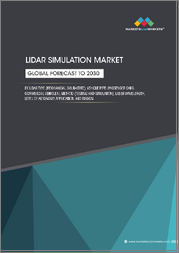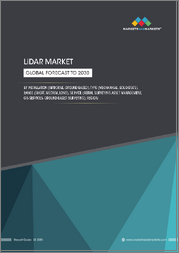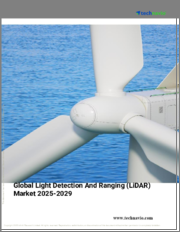
|
시장보고서
상품코드
1775341
광위상배열 LiDAR 시장 : 예측(2025-2030년)Optical-Phased Array LiDAR Market - Forecasts from 2025 to 2030 |
||||||
광위상배열 LiDAR 시장은 2025년 4억 4,951만 9,000달러에서 2030년에는 13억 1,071만 7,000달러로 성장할 것으로 예측되며, CAGR 23.87%를 기록할 것으로 예상됩니다.
광위상배열 LiDAR 기술은 기존 LiDAR 시스템의 고도의 진화를 나타내며, 종합적인 환경 인식을 유지하면서 더 미세한 감지 기능을 제공합니다. 이 기술은 보다 광범위한 맥락에서 정확한 물체 위치 파악이 가능하기 때문에 높은 정확도와 통합성이 요구되는 애플리케이션에 매우 적합합니다. 광위상배열 LiDAR 시장은 자동차 분야를 중심으로 다양한 산업에서 자동화가 진행되고 있는 것을 배경으로 크게 성장할 것으로 예상됩니다. 비용 효율성, 대량 생산 가능성, 차량 설계와의 완벽한 통합 등의 주요 특성이 그 매력을 더하고 있습니다. 그러나 이 기술의 능력에 대한 오해가 문제가 되어 대체 솔루션에 대한 선호도를 떨어뜨리고 시장 침투를 제한할 수 있습니다. 이 보고서는 시장 세분화, 지리적 전망, 성장 요인에 중점을 두고 업계 전문가를 대상으로 작성되었습니다.
시장 세분화 분석
구성요소별
세계 광위상배열 LiDAR 시장은 송신기와 수신기로 구분됩니다. 이러한 구성요소들은 시너지 효과를 발휘하여 LiDAR의 기능을 최적화하고 정확한 탐지 및 환경 매핑을 보장합니다. LiDAR의 고해상도 기능을 구현하는 데 중요한 역할을 하기 때문에 시장 점유율이 크게 증가할 것으로 예상됩니다. 부품 설계 및 제조의 발전은 그 효율을 더욱 향상시켜 전체 애플리케이션에 폭넓게 적용될 수 있도록 지원할 것으로 보입니다.
용도별
광위상배열 LiDAR 기술은 자율주행차, 정밀 로봇, 자유공간 광통신에 적용되고 있습니다. 그 중에서도 정밀 로봇은 자동화의 급격한 증가와 제조, 물류, 헬스케어 등의 산업에서 로봇 시스템의 통합이 진행되면서 시장 점유율을 독식할 것으로 예측됩니다. 자율주행차 부문은 자율주행 기술의 지속적인 혁신으로 강력한 성장이 기대되는 분야입니다. 프리스페이스 광통신은 작은 부문이지만, 고정밀 데이터 전송을 제공하는 기술의 능력으로 인해 통신 및 항공우주 분야의 새로운 사용 사례를 뒷받침하고 있습니다.
지리적 전망
광위상배열 LiDAR 시장은 지리적으로 북미, 남미, 유럽, 중동 및 아프리카, 아시아태평양으로 구분됩니다. 북미는 자동화 및 자동차 산업의 눈부신 발전으로 인해 세계 시장을 주도할 것으로 예상됩니다. 이 지역은 연구개발에 집중하고 있으며, 자율주행차 기술에 대한 막대한 투자와 함께 광위상배열 LiDAR 채택의 거점으로 자리매김하고 있습니다. 아시아태평양 역시 중국, 일본 등 국가의 급속한 산업화와 자동화 발전에 힘입어 괄목할 만한 성장이 예상됩니다. 유럽은 자동차 산업이 확립되어 있고, 기술 혁신에 중점을 두고 있기 때문에 그 뒤를 잇습니다. 중동 및 아프리카와 남미는 신흥 시장으로, 자동화 기술이 확산됨에 따라 채택이 꾸준히 확대될 것으로 예상됩니다.
시장 성장요인
광위상배열 LiDAR 시장의 주요 촉진요인은 자동차 산업, 특히 자율주행차 개발에 대한 투자와 기술 혁신의 증가입니다. 이러한 자동차는 안전한 항법 및 장애물 감지를 위해 LiDAR 기술에 크게 의존하고 있으며, 이는 광위상배열 LiDAR와 같은 첨단 솔루션에 대한 강력한 수요를 창출하고 있습니다. 이 기술은 저비용으로 고해상도 스캐닝을 제공할 수 있고, 확장 가능한 생산이 가능하기 때문에 제조업체에게 특히 매력적인 기술입니다. 각 산업 분야에서 자동화가 지속적으로 확대되고 있는 가운데, 광위상배열 LiDAR를 탑재한 정밀 로봇에 대한 수요도 증가하여 시장 성장을 더욱 촉진할 것으로 예상됩니다. 또한, 현재 진행 중인 기술 발전으로 LiDAR 시스템의 성능과 신뢰성이 향상되고 있어 차세대 차량 및 로봇 시스템에 탑재하는 것이 더욱 매력적으로 다가오고 있습니다.
과제
광위상배열 LiDAR 시장은 그 잠재적 가능성에도 불구하고, 그 기능에 대한 오해로 인해 어려움에 직면해 있습니다. 업계 이해관계자들 중 일부는 광전면 어레이 LiDAR의 장점에 대한 인식 부족과 한계로 인해 레더나 카메라 베이스 시스템과 같은 대체 센싱 기술을 선호하기도 합니다. 광전면 어레이 LiDAR의 우수한 탐지 능력에 대한 교육 및 시연을 통해 이러한 오해를 해소하는 것은 광전면 어레이 LiDAR의 시장 잠재력을 극대화하는 데 매우 중요합니다.
결론
광위상배열 LiDAR 시장은 자동화, 특히 자율주행차 및 정밀 로봇 공학의 발전에 힘입어 강력한 성장이 예상됩니다. 북미가 시장을 주도하고 아시아태평양과 유럽이 크게 기여할 것으로 예상됩니다. 이 기술은 비용 효율성, 확장성, 통합 가능성으로 인해 차세대 애플리케이션을 구현하는 중요한 기술로 자리매김하고 있습니다. 그러나 시장 도입의 극대화를 위해서는 오해의 극복이 필수적입니다. 업계 이해관계자들은 이 첨단 LiDAR 기술에 대한 수요 증가에 대응하기 위해 현재 진행 중인 기술 혁신과 전략적 투자를 활용하는 데 집중해야 합니다.
본 보고서의 주요 장점
- 통찰력 있는 분석 : 고객 부문, 정부 정책 및 사회경제적 요인, 소비자 선호도, 산업별, 기타 하위 부문에 초점을 맞춘 주요 지역 및 신흥 지역을 포괄하는 상세한 시장 분석을 얻을 수 있습니다.
- 경쟁 상황 : 세계 주요 기업들이 채택하고 있는 전략적 전략을 이해하고, 적절한 전략을 통한 시장 침투 가능성을 이해할 수 있습니다.
- 시장 동향과 촉진요인 : 역동적인 요인과 매우 중요한 시장 동향, 그리고 이들이 향후 시장 개척을 어떻게 형성할 것인지에 대해 알아봅니다.
- 실행 가능한 제안 : 인사이트를 전략적 의사결정에 활용하고, 역동적인 환경 속에서 새로운 비즈니스 스트림과 수익을 발굴합니다.
- 다양한 사용자에 대응 : 스타트업, 연구기관, 컨설턴트, 중소기업, 대기업에 유익하고 비용 효율적입니다.
어떤 용도로 사용되는가?
산업 및 시장 인사이트, 사업 기회 평가, 제품 수요 예측, 시장 진입 전략, 지리적 확장, 설비 투자 결정, 규제 프레임워크 및 영향, 신제품 개발, 경쟁의 영향
조사 범위
- 2022년부터 2024년까지의 과거 데이터와 2025년부터 2030년까지의 예측 데이터
- 성장 기회, 도전과제, 공급망 전망, 규제 프레임워크 및 동향 분석
- 경쟁사 포지셔닝, 전략 및 시장 점유율 분석
- 매출 성장 및 예측 국가를 포함한 부문 및 지역별 분석
기업 소개
목차
제1장 주요 요약
제2장 시장 현황
- 시장 개요
- 시장 정의
- 조사 범위
- 시장 세분화
제3장 비즈니스 상황
- 시장 성장 촉진요인
- 시장 성장 억제요인
- 시장 기회
- Porter's Five Forces 분석
- 업계 밸류체인 분석
- 정책과 규제
- 전략적 제안
제4장 기술 전망
제5장 광위상배열 LiDAR 시장 : 구성요소별
- 소개
- 송신기
- 수신기
제6장 광위상배열 LiDAR 시장 : 용도별
- 소개
- 자율주행차
- 정밀 로봇
- 자유공간 광통신
제7장 광위상배열 LiDAR 시장 : 지역별
- 소개
- 북미
- 미국
- 캐나다
- 멕시코
- 남미
- 브라질
- 아르헨티나
- 기타
- 유럽
- 독일
- 프랑스
- 영국
- 스페인
- 기타
- 중동 및 아프리카
- 사우디아라비아
- 아랍에미리트
- 기타
- 아시아태평양
- 중국
- 인도
- 일본
- 한국
- 인도네시아
- 태국
- 기타
제8장 경쟁 환경과 분석
- 주요 기업과 전략 분석
- 시장 점유율 분석
- 합병, 인수, 합의 및 협업
- 경쟁 대시보드
제9장 기업 개요
- AEye Inc.
- Neptec Technologies Corp.
- Quanergy
- Xenomatix
- Analog Photonics
- VanJee Technology Co Ltd
- Litratech
- Luminwave
제10장 부록
- 통화
- 가정
- 기준 연도와 예측 연도 타임라인
- 이해관계자에 대한 주요 이점
- 조사 방법
- 약어
The optical-phased array LiDAR market is expected to grow from USD 449.519 million in 2025 to USD 1,310.717 million in 2030, at a CAGR of 23.87%
Optical-phased array LiDAR technology represents an advanced evolution of traditional LiDAR systems, offering finer detection capabilities while maintaining comprehensive environmental awareness. This technology enables precise object localization within a broader contextual view, making it highly suitable for applications requiring high accuracy and integration. The market for optical-phased array LiDAR is poised for significant growth, driven by increasing automation across various industries, particularly in the automotive sector. Key attributes such as cost-effectiveness, high-volume production potential, and seamless integration with vehicle designs enhance its appeal. However, misconceptions about the technology's capabilities pose challenges, potentially diverting preference toward alternative solutions and limiting market penetration. This summary, tailored for industry experts, focuses on market segmentation, geographical outlook, and growth factors, excluding data prior to 2024 as per the provided directive.
Market Segmentation Analysis
By Component
The global optical-phased array LiDAR market is segmented into transmitters and receivers. These components work synergistically to optimize LiDAR functionality, ensuring precise detection and environmental mapping. Together, they are expected to capture a significant market share due to their critical role in enabling the technology's high-resolution capabilities. Advancements in component design and manufacturing are likely to further enhance their efficiency, supporting broader adoption across applications.
By Application
Optical-phased array LiDAR technology finds applications in autonomous vehicles, precision robots, and free-space optical communication. Among these, precision robots are anticipated to dominate the market share, fueled by the surge in automation and the increasing integration of robotic systems across industries such as manufacturing, logistics, and healthcare. The autonomous vehicle segment is expected to experience robust growth, driven by ongoing innovations in self-driving technology. Free-space optical communication, while a smaller segment, benefits from the technology's ability to provide high-precision data transmission, supporting emerging use cases in telecommunications and aerospace.
Geographical Outlook
The optical-phased array LiDAR market is segmented geographically into North America, South America, Europe, the Middle East and Africa, and the Asia Pacific. North America is projected to lead the global market, driven by significant advancements in automation and the automotive industry. The region's strong focus on research and development, coupled with substantial investments in autonomous vehicle technology, positions it as a hub for optical-phased array LiDAR adoption. The Asia Pacific region is also expected to witness notable growth, supported by rapid industrialization and increasing automation in countries like China and Japan. Europe follows closely, with its established automotive sector and emphasis on technological innovation. The Middle East and Africa, along with South America, are emerging markets where adoption is expected to grow steadily as automation technologies gain traction.
Market Growth Factors
The primary driver of the optical-phased array LiDAR market is the rising investment and innovation in the automotive industry, particularly in the development of self-driving cars. These vehicles rely heavily on LiDAR technology for safe navigation and obstacle detection, creating a strong demand for advanced solutions like optical-phased array LiDAR. The technology's ability to offer high-resolution scanning at a lower cost and with scalable production makes it particularly attractive for manufacturers. As automation continues to expand across industries, the demand for precision robots equipped with optical-phased array LiDAR is also expected to rise, further supporting market growth. Additionally, ongoing technological advancements are improving the performance and reliability of LiDAR systems, making them more appealing for integration into next-generation vehicles and robotic systems.
Challenges
Despite its potential, the optical-phased array LiDAR market faces challenges due to misconceptions about its capabilities. Some industry stakeholders may favor alternative sensing technologies, such as radar or camera-based systems, due to perceived limitations or lack of awareness about optical-phased array LiDAR's advantages. Addressing these misconceptions through education and demonstration of the technology's superior detection capabilities will be critical to unlocking its full market potential.
Conclusion
The optical-phased array LiDAR market is set for robust growth, driven by advancements in automation, particularly in autonomous vehicles and precision robotics. North America is expected to lead the market, with significant contributions from the Asia Pacific and Europe. The technology's cost-effectiveness, scalability, and integration potential position it as a key enabler of next-generation applications. However, overcoming misconceptions will be essential to maximizing market adoption. Industry stakeholders should focus on leveraging ongoing innovations and strategic investments to capitalize on the growing demand for this advanced LiDAR technology.
Key Benefits of this Report:
- Insightful Analysis: Gain detailed market insights covering major as well as emerging geographical regions, focusing on customer segments, government policies and socio-economic factors, consumer preferences, industry verticals, and other sub-segments.
- Competitive Landscape: Understand the strategic maneuvers employed by key players globally to understand possible market penetration with the correct strategy.
- Market Drivers & Future Trends: Explore the dynamic factors and pivotal market trends and how they will shape future market developments.
- Actionable Recommendations: Utilize the insights to exercise strategic decisions to uncover new business streams and revenues in a dynamic environment.
- Caters to a Wide Audience: Beneficial and cost-effective for startups, research institutions, consultants, SMEs, and large enterprises.
What do businesses use our reports for?
Industry and Market Insights, Opportunity Assessment, Product Demand Forecasting, Market Entry Strategy, Geographical Expansion, Capital Investment Decisions, Regulatory Framework & Implications, New Product Development, Competitive Intelligence
Report Coverage:
- Historical data from 2022 to 2024 & forecast data from 2025 to 2030
- Growth Opportunities, Challenges, Supply Chain Outlook, Regulatory Framework, and Trend Analysis
- Competitive Positioning, Strategies, and Market Share Analysis
- Revenue Growth and Forecast Assessment of segments and regions including countries
Company Profiling (Strategies, Products, Financial Information, and Key Developments among others.
Key Market Segments
By Component
- Transmitter
- Receiver
By Application
- Autonomous Vehicle
- Precision Robots
- Free-Space Optical Communications
By Geography
- North America
- USA
- Canada
- Mexico
- South America
- Brazil
- Argentina
- Others
- Europe
- Germany
- France
- United Kingdom
- Spain
- Others
- Middle East and Africa
- Saudi Arabia
- UAE
- Others
- Asia Pacific
- China
- India
- Japan
- South Korea
- Indonesia
- Thailand
- Others
TABLE OF CONTENTS
1. EXECUTIVE SUMMARY
2. MARKET SNAPSHOT
- 2.1. Market Overview
- 2.2. Market Definition
- 2.3. Scope of the Study
- 2.4. Market Segmentation
3. BUSINESS LANDSCAPE
- 3.1. Market Drivers
- 3.2. Market Restraints
- 3.3. Market Opportunities
- 3.4. Porter's Five Forces Analysis
- 3.5. Industry Value Chain Analysis
- 3.6. Policies and Regulations
- 3.7. Strategic Recommendations
4. TECHNOLOGICAL OUTLOOK
5. OPTICAL-PHASED ARRAY LIDAR MARKET BY COMPONENT
- 5.1. Introduction
- 5.2. Transmitter
- 5.3. Receiver
6. OPTICAL-PHASED ARRAY LIDAR MARKET BY APPLICATION
- 6.1. Introduction
- 6.2. Autonomous Vehicle
- 6.3. Precision Robots
- 6.4. Free-Space Optical Communications
7. OPTICAL-PHASED ARRAY LIDAR MARKET BY GEOGRAPHY
- 7.1. Introduction
- 7.2. North America
- 7.2.1. USA
- 7.2.2. Canada
- 7.2.3. Mexico
- 7.3. South America
- 7.3.1. Brazil
- 7.3.2. Argentina
- 7.3.3. Others
- 7.4. Europe
- 7.4.1. Germany
- 7.4.2. France
- 7.4.3. United Kingdom
- 7.4.4. Spain
- 7.4.5. Others
- 7.5. Middle East and Africa
- 7.5.1. Saudi Arabia
- 7.5.2. UAE
- 7.5.3. Others
- 7.6. Asia Pacific
- 7.6.1. China
- 7.6.2. India
- 7.6.3. Japan
- 7.6.4. South Korea
- 7.6.5. Indonesia
- 7.6.6. Thailand
- 7.6.7. Others
8. COMPETITIVE ENVIRONMENT AND ANALYSIS
- 8.1. Major Players and Strategy Analysis
- 8.2. Market Share Analysis
- 8.3. Mergers, Acquisitions, Agreements, and Collaborations
- 8.4. Competitive Dashboard
9. COMPANY PROFILES
- 9.1. AEye Inc.
- 9.2. Neptec Technologies Corp.
- 9.3. Quanergy
- 9.4. Xenomatix
- 9.5. Analog Photonics
- 9.6. VanJee Technology Co Ltd
- 9.7. Litratech
- 9.8. Luminwave
10. APPENDIX
- 10.1. Currency
- 10.2. Assumptions
- 10.3. Base and Forecast Years Timeline
- 10.4. Key benefits for the stakeholders
- 10.5. Research Methodology
- 10.6. Abbreviations



















